1918 Pandemic and Avian Flu
01/26/2008
The following are Moodle readings (under influenza) that discuss the 1918 virus and the recent avian influenza virus
What Happened in 1918?
Background
1918 "Spanish" flu Distinguishing features:
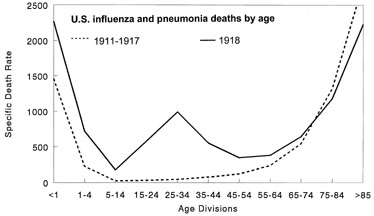
Statistics
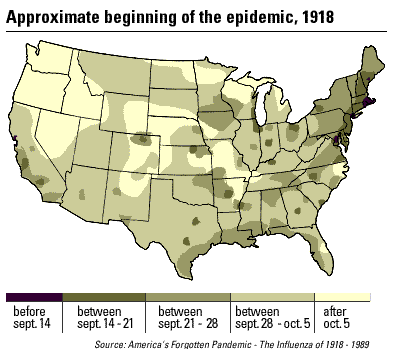
Credit: Influenza 1918 - The American Experience
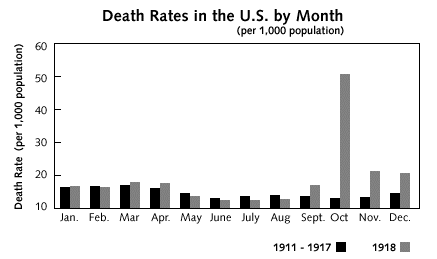
Credit: Influenza 1918 - The American Experience
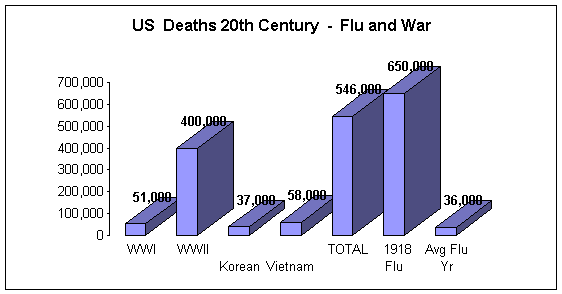
What Made the Virus So Deadly
Possible Reasons
Characteristics of Epidemic/Pandemic Viruses
| Date | Subtype | Comments | Molecular Changes |
| 1918 | H1N1 | pandemic "Spanish" Flu | |
| 1957 | H2N2 | pandemic "Asian" flu | antigenic shift |
| 1962 | H2N2 | epidemic | antigenic drift |
| 1964 | H2N2 | epidemic | antigenic drif |
| 1968 | H3N2 | pandemic "Hong Kong" flu | antigenic shift |
| 1976 | H1N1 | swine flu | |
| 1999 | H5N1 | avian flu |
|
Avian Flu |
||
| Strain | Location |
Infections deaths/cases |
| H5N1 | Hong Kong 1997 | 6/18 |
| H9N2 | Hong Kong 1999 | 0/2 |
| H5N1 | Vietnam 2004 | 20/27 |
| H5N1 | Thailand 2004 | 11/16 |
Proteins from 1918 Influenza Virus (Type A)
1918 HA has:
1918 HA salic acid binding site almost identical to avian HA
some avian H5 and H7 have additional mutation at cleavage sit of HA0 --> HA1 and HA2. Ordinarily cleaved by specific protease found in gut.. With mutation, more basic amino acids added, allow cleavage by other proteases, and addition organ diseases. HA1 from 1918 doesn't have the extra basic amino acids.
1918 NA:
Few strains that infect mice have changes in NA that allow multiple-organ infectivity. Not seen in 1918 NA.
Using a process called reverse genetics, individual 1918 genes can be added to present strains to make hybrid virus. These can be used in test animals such as mice or human cells in culture.
Add NS1 1918 gene to present influenza Normal NS1 prevent production of a host protein called interferon (IFN) which part of host defense. 1918 NS1 more effective at blocking IFN production of the infected cell.
Hybrids with both 1918 HA and NA: These were lethal in mice and resulted in multiple organ problems, and a large inflammatory response in lung.
1918 HA alone: intensive immune response.
Structure Files:
Reference:
Stevens, J. et al. Structure of the Uncleaved Human H1 Hemagglutinin from the Extinct 1918 Influenza Virus. Science, 303, pg 1866 (2004)
Gamblin, S. The Structure and Receptor Binding Properties of the 1918 Influenza Hemagglutinin. Science, 303, pg 1838 (2004)
Genetic Changes in the Virus - What Caused the Pandemic
Antigenic Drift
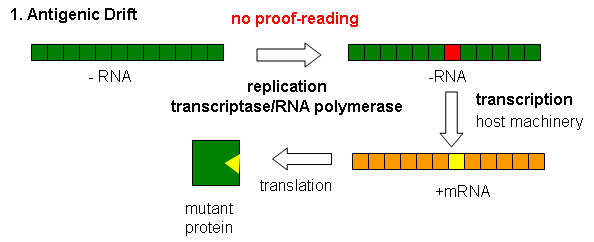
Antigenic Shift
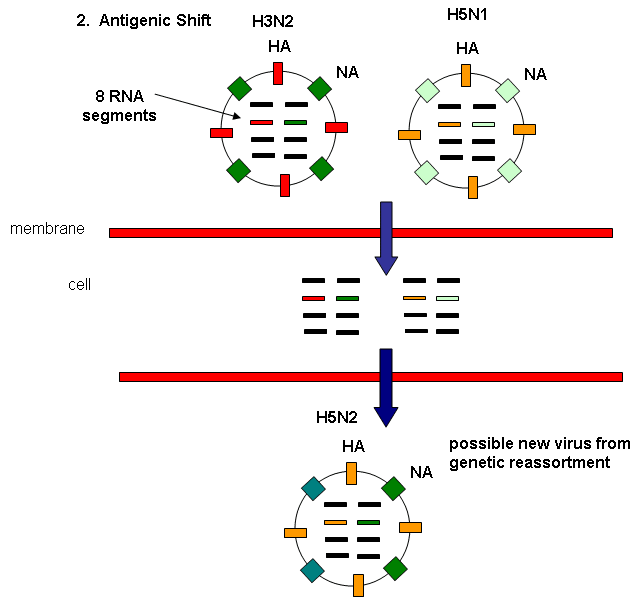
Evidences suggest that before 1918, the major strain of influenza was H3N8. This was replaced in the 1918 pandemic when an H1N1 virus arose. In the next pandemic (Asian,1957) three genes from avian influenza (PB1, HA, and NA) replaced their counterparts in the H1N1 strain, presumably through reassortment as shown above, to give the pandemic strain H2N2. Again through a similar process, the PB1 and HA genes from the prevalent strain where replaced by avian genes to produce the Hong Kong H3N2 pandemic strain.
In addition, the sequence of viruses can be compared and phylogenetic tree can be created, not unlike family trees of inheritance. The 1918 virus appears most related to human and swine influenza virus, not avian, but it does clearly have avian features (such as the gene for HA described above). It may have emerged from avian reservoir before 1918, for which no specimen has yet been found to compare. That virus may have then acquired enough mutations to make it infective in mammals. There is yet another possibility: the 1918 virus came directly from a completely different avian source (somewhat like SARS which emerge from civets).
The 1957 and 1968 pandemic virus had new avian-like HA. These Probably arose from reassortment, as described above.
Annenberg animations -Influenza infections
Could it happen again? The avian flu scare
The Avian Flu Links
Additional links:
General Links: